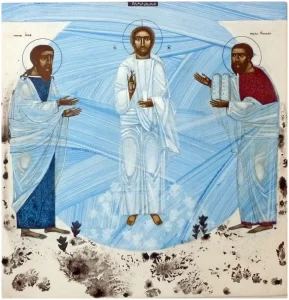Ord Om ordet
Transfiguration
Daniel 7.9-14: A stream of fire issued from his presence.
Luke 9.28-36: His clothing became brilliant as lightning.
Today’s feast commemorates an historical event, a moment of transition in the public life of Jesus. Before it, he appears as a preacher and healer, in continuity with the prophets of Israel. The Transfiguration brings a change of register. From now on the Gospel will be principally about, not his works, but the manifestation of his being; it will be less about the words he speaks than about the Word he embodies.
Our gaze is turned towards the cross-shaped redemption he is set to accomplish. It will be wrought in squalor, seen as annihilation, but will yet be glorious, as we learn from St John the Evangelist, one of the witnesses who, high on Tabor, beheld Christ’s glory in its fearful splendour.
So the Transfiguration refers to a particular epiphany. But its relevance is not constricted to this transitory scene. The Transfiguration reveals an intrinsic aspect of the Person of the Word, a current of divinity transmitted by his human nature so that we, if we are on the right wavelength, might capture it.
The glory manifest on Tabor belongs to Jesus as properly his. It is alive in him from his conception in Mary’s womb until his death on the cross and holy resurrection; it remains present in the Church’s sacramental life. The Holy Sacrifice we celebrate this morning carries a ray of this light, ‘brilliant as the sun’. Its purpose is to enflame us, too.
It is sometimes said that we need, these days, a ‘re-sacralisation’ of the liturgy and Christian practice. This is not false, I believe, but we need to be careful: let’s not consider ‘sacralisation’ an end in itself. The pursuit of idealised ‘sacredness’ easily leads to idolatry, for man is inclined to envisage it as a reflection of himself. The Old Testament condemns this tendency. Its strictures remain timely. For a Christian, there is no such thing as ‘the sacred’; what is truly sacred indicates, quite simply, a trace of the presence of our God Three-in-One, rendered palpable by the Word, conveyed by the Spirit.
What we need to develop is an ability to see God ‘as he is’. We have to purify our vision, turning it away from deceptive lights that blind us, rather the way the phosphorescent glare of our cities hides from us the stars. We must actively seek the glory Jesus displays through each stage of his life; we must re-read Scripture with the Transfiguration as our hermeneutic key; we must recognise the glory that shines in the sacraments in order, then, to correspond to it by our way of life.
Each time we recite the creed, we confess that Mary’s Son is ‘God from God, Light from Light’. This affirmation implies a call for our illumination in Christ, who nurtures us with himself to renew our being in his likeness.
The greatest obstacle to Christian perfection is, I’d say, our tendency to forget the lofty intention God has for us or to doubt that he is capable of realising it.
May this feast restore our trust, courage, and enthusiasm. May it provoke in us an existential thirst not satisfied by dull, stagnant water stored up in cisterns, making us yearn instead to drink from the source that springs up to everlasting, glorified life. Amen.

